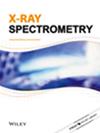宏观x射线荧光与反射成像光谱在架上绘画颜料半定量分析中的比较:铅白和蓝染色剂的研究
IF 1.5
4区 物理与天体物理
Q3 SPECTROSCOPY
引用次数: 0
摘要
宏观x射线荧光成像光谱(MA - XRF)和反射成像光谱(RIS)是文化遗产分析的重要工具,无论是用于保护还是用于艺术史研究。MA - XRF和RIS分别提供的元素和分子分布对架上绘画中颜料的识别和定位特别有用。虽然MA - XRF已经相对建立了基于底层物理建模的数据处理方法,但RIS数据无法以足够的精度建模,其处理还有相当大的改进空间。本研究旨在通过一种新颖的方法改善短波红外范围(SWIR, 1000-2500 nm)的RIS数据处理工作流程,该方法将高斯分布与色素特异性吸收特征相匹配,并将其性能与MA - XRF进行半定量色素映射任务的比较,评估其检测限(lod)和影响其信号的矩阵效应。本研究考虑了两种色素,铅白和蓝色素,它们分别在1447和1497 nm的SWIR RIS中使用其主要化合物氢铜矿(Pb3(CO3)2(OH)2)和蓝铜矿(Cu3(CO3)2(OH)2)的第一泛音拉伸来定位,在MA - XRF中使用Pb‐L和Cu‐K荧光信号。使用两套定制制备的油漆样品以及一幅16世纪的绘画来评估这些方法,讨论了所考虑的颜料的鉴定、绘图和半定量分析。我们发现SWIR RIS是一种色素特异性方法,具有较长的线性范围,但与MA - XRF相比,lod和穿透深度较差,MA - XRF通常无法区分具有相同元素标记的不同色素。我们进一步提出了一种新的色标,可以同时显示高于和低于置信限的信号。本文章由计算机程序翻译,如有差异,请以英文原文为准。
Comparison of macro x‐ray fluorescence and reflectance imaging spectroscopy for the semi‐quantitative analysis of pigments in easel paintings: A study on lead white and blue verditer
Macroscopic x‐ray fluorescence imaging spectroscopy (MA‐XRF) and reflectance imaging spectroscopy (RIS) are important tools in the analysis of cultural heritage objects, both for conservation and art historical research purposes. The elemental and molecular distributions provided by MA‐XRF and RIS respectively, are particularly useful for the identification and mapping of pigments in easel paintings. While MA‐XRF has relatively established data processing methods based on modeling of the underlying physics, RIS data cannot be modeled with sufficient precision and its processing has considerable room for improvements. This work seeks to improve RIS data processing workflows in the short wavelength infrared range (SWIR, 1000–2500 nm) with a novel method that fits Gaussian profiles to pigment‐specific absorption features, and we compare its performance to MA‐XRF for the task of semi‐quantitative pigment mapping, evaluating their limits of detection (LODs) and the matrix effects that affect their signals. Two pigments are considered in this work, lead white and blue verditer, which are mapped in SWIR RIS using the first overtone of OH stretching of their primary compounds, hydrocerussite (Pb3(CO3)2(OH)2) and azurite (Cu3(CO3)2(OH)2), at 1447 and 1497 nm respectively, and in MA‐XRF using the Pb‐L and Cu‐K fluorescence signals. The methods are evaluated using two sets of custom‐prepared paint samples, as well as a 16th‐century painting, discussing the identification, mapping, and semi‐quantitative analysis of the considered pigments. We found SWIR RIS to be a pigment‐specific method with a longer linear range but inferior LODs and penetration depth when compared to MA‐XRF, the latter is often not capable of discriminating between different pigments with identical elemental markers. We furthermore present a novel color scale that allows the simultaneous visualization of signals above and below a confidence limit.
求助全文
通过发布文献求助,成功后即可免费获取论文全文。
去求助
来源期刊

X-Ray Spectrometry
物理-光谱学
CiteScore
3.10
自引率
8.30%
发文量
38
审稿时长
6-12 weeks
期刊介绍:
X-Ray Spectrometry is devoted to the rapid publication of papers dealing with the theory and application of x-ray spectrometry using electron, x-ray photon, proton, γ and γ-x sources.
Covering advances in techniques, methods and equipment, this established journal provides the ideal platform for the discussion of more sophisticated X-ray analytical methods.
Both wavelength and energy dispersion systems are covered together with a range of data handling methods, from the most simple to very sophisticated software programs. Papers dealing with the application of x-ray spectrometric methods for structural analysis are also featured as well as applications papers covering a wide range of areas such as environmental analysis and monitoring, art and archaelogical studies, mineralogy, forensics, geology, surface science and materials analysis, biomedical and pharmaceutical applications.
 求助内容:
求助内容: 应助结果提醒方式:
应助结果提醒方式:


